My fly boxes
{{start}}
The number of fly boxes you carry is obviously one of personal choice. One difficulty you may encounter when you are setting up your fly boxes is which flies you should include, and how many flies you should carry in your fly box or boxes. The last thing you want to be doing is standing on the bank of a river madly pulling flies out to find a fly you know is there . . .somewhere, but it isn’t where you expected to find it or you fly box or boxes are so crowded with flies that the one you are desperately looking for is hidden away . . . somewhere.
{{end}}
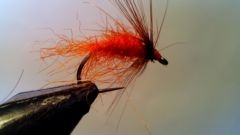
{{+1}}Carrot dry fly{{-1}}
{{start}}
Tied with natural seals fur it is a fly that sits well on the water and easily sheds water with a snappy false cast.{{end}}
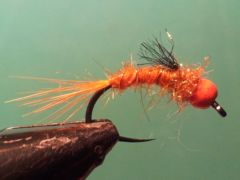
{{+1}}Carrot wet fly{{-1}}
{{start}}
This fly came about as an extension of the idea of using very popular carrot dry fly and has turned out to be a great weighted attractor fly to use on the top or middle dropper when fishing a representation fly on the point to river fish.{{end}}
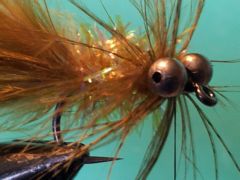
{{+1}}Double eyed, soft hackle dog nobbler{{-1}}
{{start}}
At the same time the woolly bugger was evolving in the US in England a similar fly that became known as a dog nobbler was also evolving. Dog nobbler flies were heavily weighted for use in deeper water, were generally not palmered with a hackle and often were tied with bead chain eyes.{{end}}
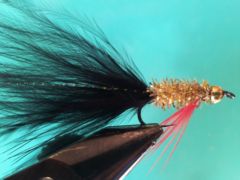
{{+1}}Humungus variant{{-1}}
{{start}}
Tied with a woolly bugger tail that allows movement within the fly, a plain, painted or anodised tungsten bead for the head that encourages up and down movement and of course plenty of fleeting colour as it is stripped through the water this fly is very much a top class pulling fly... and very effective in that role.{{end}}
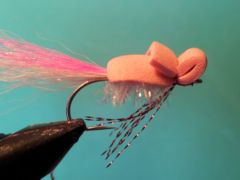
{{+1}}Gartside gurgler{{-1}}
{{start}}
Fishing with a gurgler can be very exciting because you often see the fish behind the fly just before it strikes. With fairly subtle changes you can vary this fly to fit a wide range of surface fishing situations.{{end}}
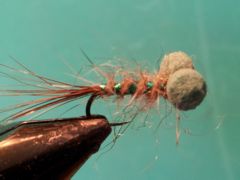
{{+1}}Hares ear booby{{-1}}
{{start}}
This is a nifty little fly that merges the hares ear nymph and the traditional booby both very high pedigree flies into one very useful loch fly. It also has a bit of flash about it which helps the fly fill an important role in my fly box for an attractor fly to use on my middle dropper when I loch style fish fish just before, through and after the trout spawning season.{{end}}
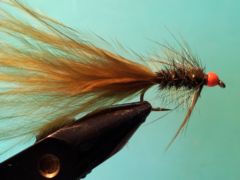
{{+1}}BH olive damsel bugger{{-1}}
{{start}}
At different times of the year you will start to see swallows dipping on the water feeding on midge. This is the time to start thinking about fishing either damsel buggers or olive woolly buggers because unfortunately for the midge it's not only swallows that have them on their menu it's also carnivorous damsel nymphs. Damsel nymphs come in a range of colours ranging from dull browns through to light and dark olives.{{end}}
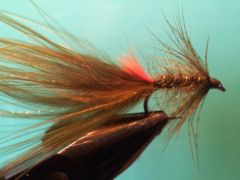
{{+1}}Mark II woolly bugger – alternate tie{{-1}}
{{start}}
The MK 2 woolly buggers evolved from standard black and olive woolly buggers as a fly that would imitate an American frog that had bright red between its hind legs and consequently the red tag is traditionally tied in below the tail. This tie is a little more popular than the original tie these days and is main point of difference is that the tag tied in on top.{{end}}
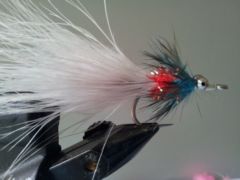
{{+1}}Gusto{{-1}}
{{start}}
This is a Peter Morse fly and a great variation on a Wooly Bugger that is making its mark in fresh water fly fishing. It's dressed on a wide gape hook that creates an effective "keel" effect and sports a relatively long marabou tail and a dense collar which together create plenty of currents around the fly that really get the marabou moving. It is adaptable for a range of species and situations.{{end}}
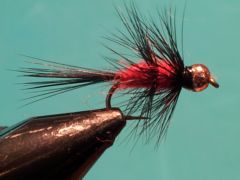
{{+1}}TBH fuzzy wuzzy{{-1}}
{{start}}
If you went back just a few years and you a asked an average fly fisher to name his for her favorite fly chances are it would be an unweighted, or lightly weighted probably with a few turns of lead wire, Fuzzy Wuzzy. The traditional Fuzzy Wuzzy has always been useful as a river and lake fly leading up to, through and just after the spawning season. This fly just extends the application of the standard Fuzzy Wuzzy an little further and the simple addition of the tungsten bead head makes it easier to get this fly down and bumping along the bottom where the fish are.{{end}}













